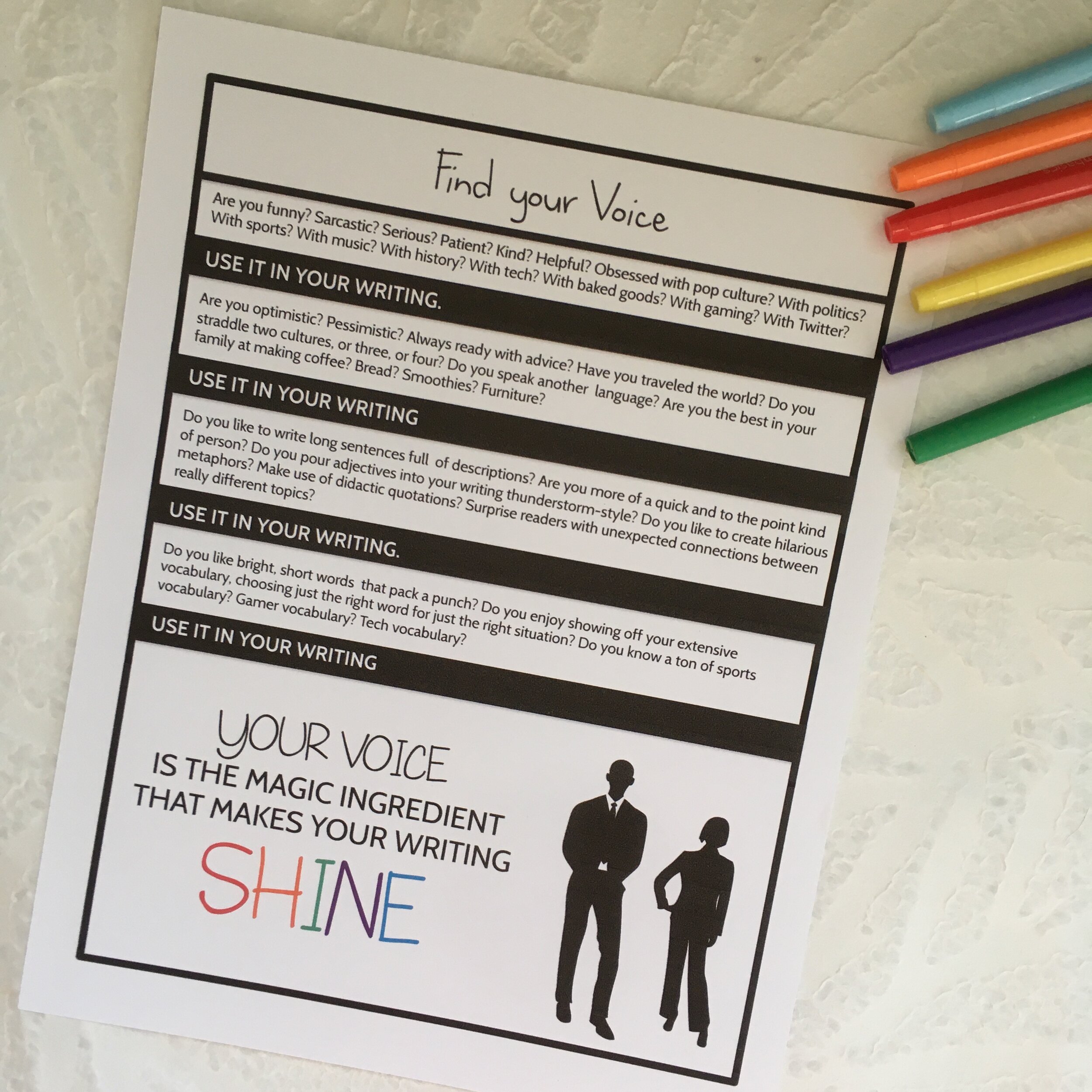Teaching Voice in Writing: Easy Tips for ELA
Voice isn’t easy to teach. Especially in an era of photocopied excerpt reading programs and standardized testing. It’s easy to feel like you have to show students standard formulas for producing expository essays that will check all the boxes, cite the right number of quotes, and wrap it up in a neat little package for the man.
But it doesn’t have to be this way. Writing can breathe and shine. Writing can drip with excitement, churn with emotion, struggle with injustice. Writing can be intensely personal, revealing the life experiences and beliefs of the writer.
How do we get there? How do we take the “encyclopedia voice” (Mariconda) many students come into the classroom having been taught, and turn it into Walt Whitman’s much-lauded “barbaric yawp”?
Voice in expository writing (as opposed to fiction) is about a lot of things. It’s about word choice, sentence structure, tone. It’s about what kinds of metaphors and cultural references a student would choose. What anecdotes they would tell to explain something. What they find funny. What they find horrifying. It’s about who they are. Just as a friend might come to them with a problem to hear their unique perspective, no one else can bring just what they can to a written piece.
It’s also about who they’re writing to, and what they’re writing about. They undoubtedly speak differently when talking to a friend about their favorite t.v. show and when talking about their grandmother’s health to their grandfather. So topic and audience play a role in voice too.
Let’s talk about a few easy ways to get students using their real voices, instead of that dry, crumbly mix of all the rules they’ve learned along the way.
#1 Re-Introduce the Concept of Voice
Students’ concepts of voice may be pretty vague by the time they get to you. They may just think of it as what makes an author or character different from another author or character, without having really thought about what that means. Show them this handout (click for the free download) and talk about what it means to share their unique voice with the world.
#2 Go on a Voice Hunt
Ask students to find a quotation in a piece of fiction they love. Any (appropriate) piece of fiction, from anything they’ve ever read.
Have them design a beautiful quotation card using Canva’s super simple Instagram quotation design tool. Either create a Google slide deck with all the quotes for the class to view, or print them and put them up in a voice gallery on the wall. Talk about what makes the different voices unique, maybe having students write down descriptors for a few.
#3 Get Cozy with First Person
While it’s both possible and desirable to use voice in a really formal piece of writing, it’s a challenge for kids just clearing their throats on paper. If you want students to start using their real voices, consider practicing with first person. Blogging is a great option. So is podcasting. Give students a chance to choose their own topics, their own audience, and their own delivery styles. As you focus in on voice, let students say “I” and “my.” Let them know it’s nothing to be afraid of.
#4 Have Students Use their Actual Voices
Try having students record their voices while they talk through what they’re going to write, then transcribe and edit from there. Often, students will realize they talk and write in totally different ways, stifling their natural voice in academic-speak they think they need to be effective.
Similarly, one of the most effective editing tools for eliminating pointless fluff from writing and making it sound more natural to the voice of the writer, is to read out loud during the editing process. Have kids read their work out loud, on their own or to a partner, and make changes where the phrasing, vocabulary, or transitions sound awkward. Remind them that the goal is to sound like themselves, so if it sounds weird in their mouths, they’ve got some adjustments to make.
#5 Experiment with Funny Voice Bell-Ringers
As you focus in on voice, ask students to throw out ideas for topics and audiences and make a big list on your board to keep up during the unit. Choose one of each for a quick write at the start of class. For example, you might have a topic of Snapchat and an audience of teachers. Ask students to write to teachers about Snapchat, thinking about how they can share their ideas in their own unique voice, while keeping their audience in mind. The next day maybe they’re writing to toddlers about high school. Or writing to politicians about their neighborhood. Or to journalists about school.
OK, ready to go help students find their voices? It’s going to be fun!
Related Resource: MLA Posters
These posters act as an easy and colorful reference point for students struggling to get down the basics of MLA. Make the nitty gritty easy so your students can focus on their writing quality, and save your grading energy and your flair pens for other things! Find them here.
About the Author
Betsy loves to travel the world (she'll be back, Morocco!), play playdoh with her little ones, and cook a range of desserts that would make the Hogwarts house elves proud. If you're interested in creative teaching strategies, check out her podcast "The Spark Creativity Teacher Podcast" on iTunes and hop into her Facebook group "Creative High School English." Prefer Pinterest? Instagram? She'd love to meet up with you there too!
Related Readings
Empower Student Writers with a 20 Time Blogging Project
9 Ways to get Secondary Students to Enjoy Writing
3 Mini-Lessons to help your Students Finally Understand and Effectively Use Formal Writing
Sources:
Cler, Stacy. “Helping Students Find their Voice.” PBS Teacher’s Lounge, PBS Online, November 7, 2018, www.pbs.org/education/blog/helping-students-find-their-voice. Accessed January 2020.
Mariconda, Barbara. “The 2 Voices in Writing and How to Teach Them.” Empowering Writers Online. www.empoweringwriters.com/toolbox/teaching-voice-in-writing-barbara-mariconda/. Accessed January 2020.
McCarthy, John. “The Mechanics of Developing a Writer’s Voice.” Edutopia, Edutopia.org, August 21, 2017. www.edutopia.org/article/mechanics-developing-writers-voice. Accessed January 2020.
Whitman, Walt. “Song of Myself.” Poetry Foundation Online, 1892 version, www.poetryfoundation.org/poems/45477/song-of-myself-1892-version. Accessed January 2020.




